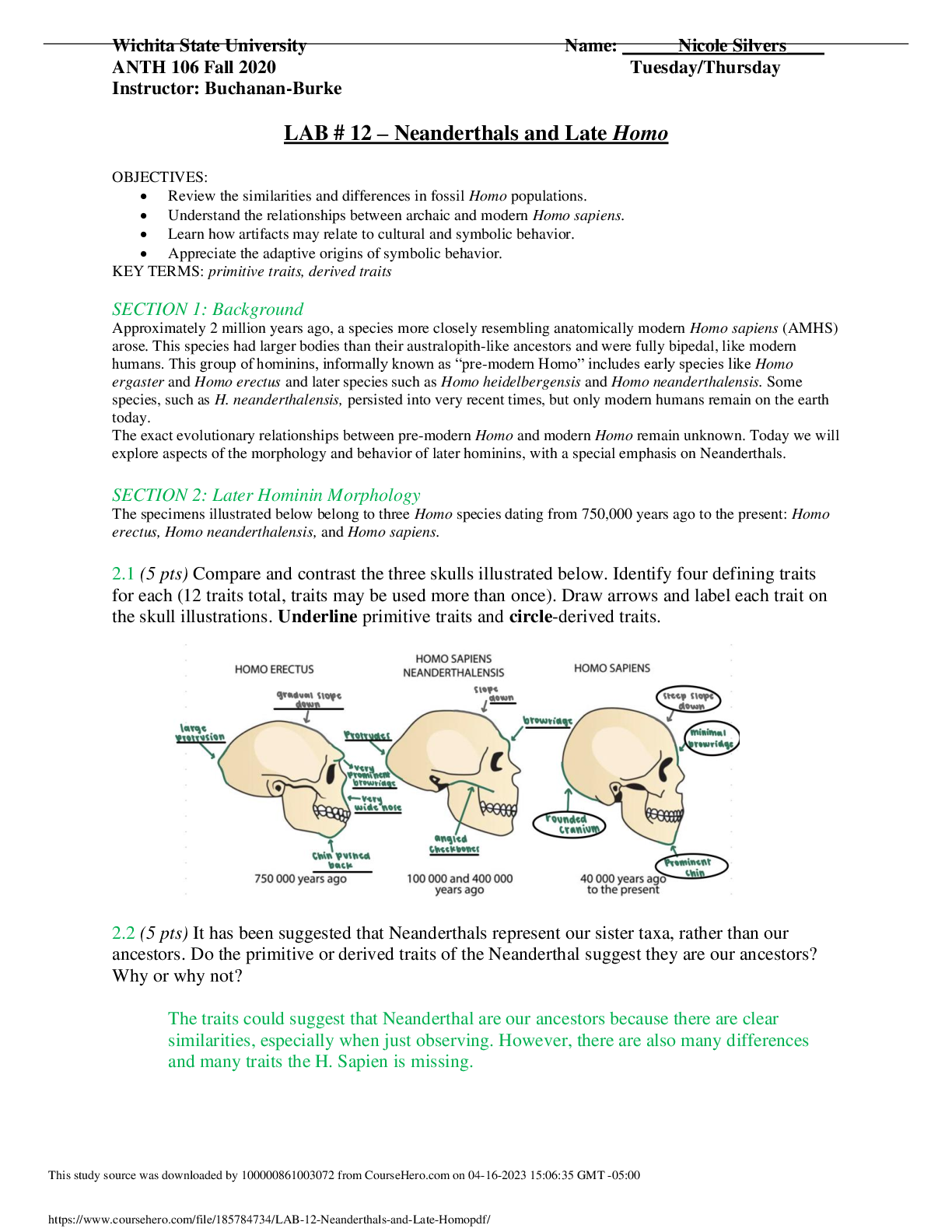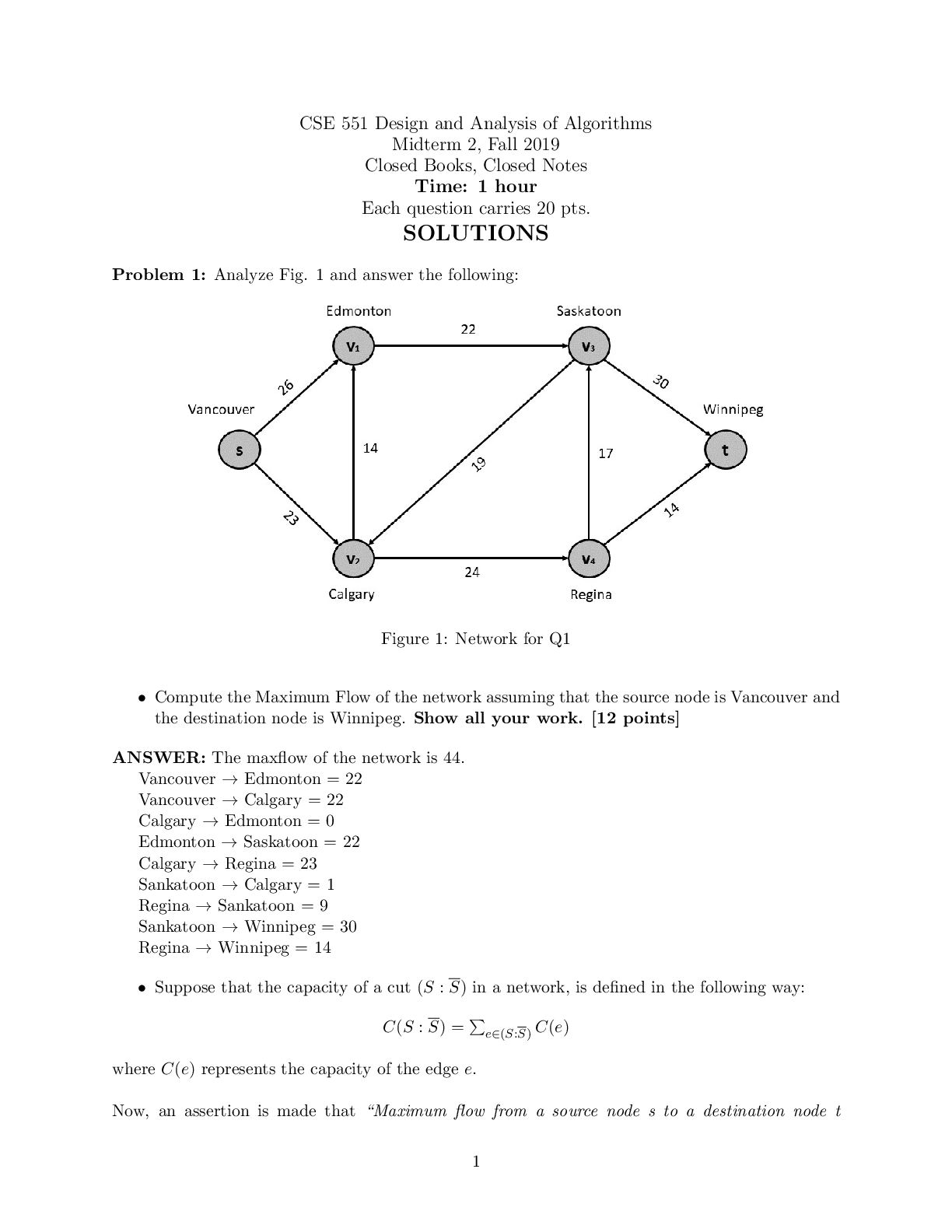Anthropology > QUESTIONS & ANSWERS > Wichita State University. ANTH 106 Biological Anthropology Lab Exam- LAB # 12 – Neanderthals and L (All)
Wichita State University. ANTH 106 Biological Anthropology Lab Exam- LAB # 12 – Neanderthals and Late Homo. Q&A
Document Content and Description Below
Wichita State University Name ANTH 106 Fall 2020 LAB # 12 – Neanderthals and Late Homo OBJECTIVES: • Review the similarities and differences in fossil Homo populations. • Understand t... he relationships between archaic and modern Homo sapiens. • Learn how artifacts may relate to cultural and symbolic behavior. • Appreciate the adaptive origins of symbolic behavior. KEY TERMS: primitive traits, derived traits SECTION 1: Background Approximately 2 million years ago, a species more closely resembling anatomically modern Homo sapiens (AMHS) arose. This species had larger bodies than their australopith-like ancestors and were fully bipedal, like modern humans. This group of hominins, informally known as “pre-modern Homo” includes early species like Homo ergaster and Homo erectus and later species such as Homo heidelbergensis and Homo neanderthalensis. Some species, such as H. neanderthalensis, persisted into very recent times, but only modern humans remain on the earth today. The exact evolutionary relationships between pre-modern Homo and modern Homo remain unknown. Today we will explore aspects of the morphology and behavior of later hominins, with a special emphasis on Neanderthals. SECTION 2: Later Hominin Morphology The specimens illustrated below belong to three Homo species dating from 750,000 years ago to the present: Homo erectus, Homo neanderthalensis, and Homo sapiens. 2.1 (5 pts) Compare and contrast the three skulls illustrated below. Identify four defining traits for each (12 traits total, traits may be used more than once). Draw arrows and label each trait on the skull illustrations. Underline primitive traits and circle-derived traits. 2.2 (5 pts) It has been suggested that Neanderthals represent our sister taxa, rather than our ancestors. Do the primitive or derived traits of the Neanderthal suggest they are our ancestors? Why or why not? LAB # 12 – Neanderthals and Late Homo This map shows the known range of Neanderthals from ~130,000 to 30,000 years ago. As you can see, the geographic range is broad. Within this area are many different environments which experienced several large-scale climatic changes over the millennia. Because variation exists in all populations, it can be reasonably expected to find geographic variation within Neanderthals. Consider the mandibles from different Neanderthal populations. Assume that all mandibles come from adult males. 3.1 (5 pts) Are the morphological (shape) differences between humans and Neanderthals different enough to justify classifying them into different species? 3.2 (5 pts) Humans, primarily from Europe, exhibit a small percentage of Neanderthal DNA in their genomes. What does this mean in regards to the evolution of modern humans? Are Neandertals and Homo sapiens different species? All later hominins were adept tool-users. Over evolutionary time, tools have become much more complicated in order to accomplish new and harder tasks. This kind of behavioral evolution can be observed in artifacts left at fossil sites, and archaeologists often use these artifacts to make hypotheses concerning the lifestyles of our extinct relatives. Consider some common stone tool industries and answer the following questions. Oldowan: simple stone tool technology with flakes and choppers, associated with early Homo Acheulean: flakes and bifacial tools including handaxes, associated with H. ergaster and H. erectus Mousterian: smaller stone flakes or blades with long edges, made through a process that more efficiently produces sharp edges and flakes of a given shape from a core, associated with H. neanderthalensis Wichita State University Name: ______Nicole Silvers____ ANTH 106 Fall 2020 LAB # 12 – Neanderthals and Late Homo 4.1 (5 pts) How do these stone tools differ from one another (manufacture, purpose, etc.)? 4.2 (5 pts) Is it possible that these tools represent different stages of development along the path to a more complicated tool, or do they represent distinct technologies? 4.3 (5 pts) What can the differences in the stone tools tell us about the individuals who made them? (10 pts) The origin of our complex cultures and symbolic behavior is unknown, but many researchers argue that it preceded the biological transition to AMHS. Based on your knowledge of hominin evolution and comparative primatology, when do you think behavioral modernity emerged? Did culture emerge at the same time? Make sure to provide support for your theory. 1 page, typed, double sp [Show More]
Last updated: 2 years ago
Preview 1 out of 4 pages

Buy this document to get the full access instantly
Instant Download Access after purchase
Buy NowInstant download
We Accept:

Reviews( 0 )
$8.50
Can't find what you want? Try our AI powered Search
Document information
Connected school, study & course
About the document
Uploaded On
Apr 23, 2023
Number of pages
4
Written in
Additional information
This document has been written for:
Uploaded
Apr 23, 2023
Downloads
0
Views
1231















